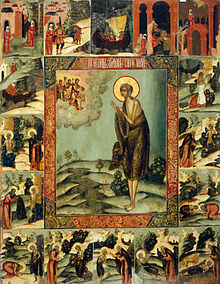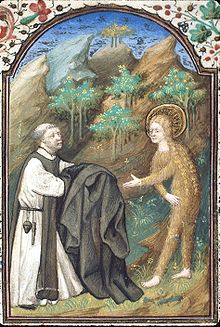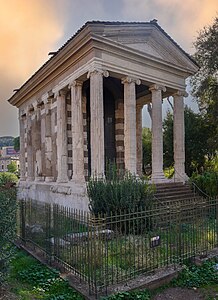Mary of Egypt
Mary of Egypt | |
|---|---|
 18th-century Russian icon of Saint Mary of Egypt | |
| Born | Province of Egypt |
| Died | Trans-Jordan desert, Palaestina I |
| Venerated in | |
| Canonized | Pre-congregation |
| Feast |
|
| Attributes | Cilice, skull, loaves of bread |
| Patronage | Chastity (warfare against the flesh; deliverance from carnal passions); demons (deliverance from); fever; skin diseases; temptations of the flesh[2] |
Mary of Egypt (Greek: Μαρία η Αιγυπτία ; Coptic: Ϯⲁⲅⲓⲁ Ⲙⲁⲣⲓⲁ Ⲛⲣⲉⲙⲛ̀ⲭⲏⲙⲓ ; Egyptian Arabic: مريم المصرية/ماريا المصريةالمصرية; Amharic/Geez: ቅድስት ማርያም ግብፃዊት) would have been an Egyptian grazer saint dwelling in Palestine during Late antiquity or the Early Middle Ages. She is highly venerated as a Desert Mother in the Eastern Orthodox and Coptic Churches. The Catholic Church commemorates her as a patron saint of penitents.
She is exclusively known through the hagiographical account of her life, a narrative in Greek written by Sophronius of Jerusalem in the 7th century. Her existence is uncertain and has been questioned by some historians.
Life[edit]

The primary source of information on Saint Mary of Egypt is the Vita written of her by Sophronius, Patriarch of Jerusalem (634–638).[3] Most of the information in this section is taken from this source.
Mary of Egypt, also known as Maria Aegyptiaca, was born somewhere in the Province of Egypt, and at the age of twelve ran away from her parents to the city of Alexandria. There, she lived an extremely dissolute life.[4] In her Vita it states that she often refused the money offered for her sexual favors, as she was driven "by an insatiable and an irrepressible passion", and that she mainly lived by begging, supplemented by spinning flax.
After seventeen years of this lifestyle, she traveled to Jerusalem for the Great Feasts of the Exaltation of the Holy Cross. She undertook the journey as a sort of "anti-pilgrimage", stating that she hoped to find in the pilgrim crowds at Jerusalem even more partners to sate her lust. She paid for her passage by offering sexual favors to other pilgrims, and she briefly continued her habitual lifestyle in Jerusalem. Her Vita relates that when she tried to enter the Church of the Holy Sepulchre for the celebrations, she was barred by an unseen force. Realizing this was because of her impurity, she was struck with remorse, and upon seeing an icon of the Theotokos (the Virgin Mary) outside the church, she prayed for forgiveness and promised to give up the world (i.e., become an ascetic). She attempted again to enter the church, and this time was able to go in. After venerating the relic of the True Cross, she returned to the icon to give thanks, and heard a voice telling her, "If you cross the Jordan, you will find glorious rest." She immediately went to the monastery of Saint John the Baptist on the banks of the River Jordan, where she received absolution and afterwards Holy Communion. The next morning, she crossed the Jordan eastwards and retired to the desert to live the rest of her life as a hermit in penitence. She took with her only three loaves of bread she had bought, and once she had eaten these, lived only on what she could find in the wilderness.[5]
Approximately one year before her death, she recounted her life to Zosimas of Palestine,[6] who encountered her in the desert. When he unexpectedly met her in the desert, she was completely naked and almost unrecognizable as human. She asked Zosimas to toss her his mantle to cover herself with, and then she narrated her life's story to him. She asked him to meet her at the banks of the Jordan on Holy Thursday of the following year, and to bring her Holy Communion. When he fulfilled her wish, she crossed the river to get to him by walking on the water, and received Holy Communion, telling him to meet her again in the desert the following Lent.
The next year, Zosimas went to the same spot where he first met her, some twenty days' journey from his monastery. There, he found her lying dead; an inscription written in the sand next to her head stated that she had died the very night he had given her Communion, her incorrupt body miraculously transported to that spot. He buried her body with the assistance of a passing lion. On returning to his monastery, he related her life story to the other brethren, and it was preserved among them as oral tradition until it was written down by Sophronius.

Date of death[edit]
There is disagreement among various sources regarding the dates of Mary's life. Some scholars doubt her existence, on the grounds of the similarity of her Vita to the stories of other "desert mothers": "[I]t is impossible to provide a chronology for the life of Mary, or even to establish her historicity."[7] The dates given above correspond to those in the Catholic Encyclopedia. The Bollandists place her death in 421, or 530 (see Prolog from Ohrid, 1 April). The only clue given in her Vita is the fact that the day of her repose was 1 April, which is stated to be Holy Thursday, meaning that Easter fell on 4 April that year.
Veneration[edit]
Iconography[edit]
In iconography, Mary of Egypt is depicted as a deeply tanned, emaciated old woman with unkempt gray hair, either naked and covered by her long hair or by the mantle she borrowed from Zosimas. She is often shown with the three loaves of bread she bought before her final journey into the desert.
-
The Temple of Portunus, Rome, was preserved by being rededicated to Santa Maria Egiziaca in 872.
-
Marie of Egypt (Saint-Germain l'Auxerrois).
Commemoration[edit]
Her feast day is kept by Orthodox Christians and Greek Catholics, according to the Fixed Cycle, on 1 April, and, according to the Moveable Cycle, on the fifth Sunday of Great Lent,[8] on which day it is customary for the priest to bless dried fruit after the Divine Liturgy. The Life of St Mary by Sophronius is appointed to be read during the Matins of the Great Canon of Andrew of Crete on the preceding Thursday, which is accompanied with a canon to her and Andrew sung after each ode of the Great Canon itself.
The Coptic Orthodox Church commemorates Saint Mary of Egypt on Parmouti 6,[9] which is 14 April in the Gregorian calendar.
In the Roman Rite of the Catholic Church, Saint Mary of Egypt is commemorated on 1 April according to the 2004 Roman Martyrology (Ordinary Form) and on 2 April in the 1956 Roman Martyrology (Extraordinary Form].[10]
She is venerated by Anglicans and appears on the Episcopal Church liturgical calendar.[11]
In Italy, she became associated with the patronage of "fallen women" much like Mary Magdalene, to whom similar traits were associated.
Churches[edit]
There are a number of churches and chapels dedicated to Saint Mary of Egypt, among them:
- Temple of Portunus (Santa Maria Egiziaca, Rome)
- Church of Santa Maria Egiziaca a Forcella, Naples
- Church of Santa Maria Egiziaca a Pizzofalcone, Naples
- Chapel of St. Mary of Egypt, Wawel Castle, Kraków, Poland
- Chapel in Church of the Holy Sepulchre in Jerusalem, commemorating the site of her conversion.
Relics[edit]
First-class relics of Saint Mary of Egypt are enshrined at the following churches:
- Cattedrale di Santa Maria del Fiore, Florence Italy (skull)
- Church of Santa Maria Egiziaca a Forcella, Naples, Italy (a relic encased in a bust of the saint)[12]
- Sens Cathedral, Sens, France (right foot)[13]
- Church of Agios Dimitrios, Ampelokipi, Greece[14]
- Sretensky Monastery, Moscow, Russia (a particle from the right foot)[15]
- Cathedral of Christ the Saviour, Moscow, Russia[16]
- Novo-Tikhvin Monastery, Ekaterinburg, Russia[17]
- Church of Saint Demetrios of Thessaloniki, Moscow, Russia (a particle of the right foot)[18]
- Sacred Patriarchal and Stavropegial Orthodox Monastery of St. Irene Chrysovalantou, Astoria, Queens, New York[19]
- Saint Nicholas Russian Orthodox Monastery, Fort Myers, Florida, USA (particle)[20]
Icon of the Mother of God[edit]
Two icons of the Theotokos are claimed to be the very icon before which Mary of Egypt prayed for forgiveness. One is kept in the Chapel of Saint James the Just, located on the western parvis of the Church of Holy Sepulchre.[21] The other icon is located in the Cave of Saint Athanasios the Athonite, on the southern tip of Mount Athos.[22]
Cave[edit]
The cave where Mary of Egypt spent the rest her life following her conversion is a place of pilgrimage.[23][24]
Rosa Egipcíaca[edit]
Rosa Egipcíaca, an Afro-Brazilian religious mystic and formerly enslaved prostitute, renamed herself in 1798 to honour Saint Mary of Egypt.[25] Egipcíaca was the first black woman in Brazil to write a book, Sagrada Teologia do Amor Divino das Almas Peregrinas ("Holy Theology of Divine Love of the Pilgrim Souls"), that recorded her religious visions.[26]
Cultural references[edit]

In Goethe's Faust, Mary of Egypt is one of the three penitent saints who pray to the Virgin Mary for forgiveness for Faust. Her words are set by Mahler in his 8th Symphony, as the final saint's appeal to the Mater Gloriosa.
In Ben Jonson's play Volpone (1606) one of the characters uses the expression "Marry Gip". Commentators have taken this to mean "Mary of Egypt".
Mary of Egypt is the subject of operas by Ottorino Respighi (Maria egiziaca), John Craton (Saint Mary of Egypt), and Sir John Tavener (Mary of Egypt). The Tavener opera was written in 1992 for the Aldeburgh Festival.
The Unknown Masterpiece (1831), a novella by Balzac, contains a long description of a portrait of Mary of Egypt "undressing in order to pay her passage to Jerusalem".
Nalo Hopkinson's science fiction novel, The Salt Roads, also features Mary of Egypt and takes a historical fiction approach to telling her story.
In John Berryman's Pulitzer Prize winning book of poetry, The Dream Songs, poem 47, subtitled "April Fool's Day, or, St. Mary of Egypt", recounts Mary of Egypt's walk across the River Jordan.
"Thrust back by hands of air from the sanctuary door" is the first line of Maria Aegyptiaca, a poem by John Heath-Stubbs about the saint (Collected Poems, p. 289).
See also[edit]
- Desert Mothers
- Syncletica of Alexandria
- Saint Mary of Egypt, patron saint archive
- Sarah of the Desert
- Margaret of Cortona
- Paula of Rome
Notes[edit]
- ^ Great Synaxaristes: (in Greek) Ἡ Ὁσία Μαρία ἡ Αἰγυπτία. 1 Απριλίου. ΜΕΓΑΣ ΣΥΝΑΞΑΡΙΣΤΗΣ.
- ^ Claude Lopez-Ginisty, A Dictionary of Orthodox Intercessions (Saint John of Kronstadt Press, Liberty, Tennessee, 1994, ISBN 0-912927-80-1).
- ^ Curtin, D. P. (May 2019). The Life of St. Mary of Egypt. Dalcassian Publishing Company. ISBN 9781088279298.
- ^ Claudine M. Dauphin (1996). "Brothels, Baths and Babes: Prostitution in the Byzantine Holy Land". Classics Ireland. 3: 47–72. doi:10.2307/25528291. JSTOR 25528291.
- ^ *MacRory, Joseph (1910). . In Herbermann, Charles (ed.). Catholic Encyclopedia. Vol. 9. New York: Robert Appleton Company.
- ^ It is possible, based on Sophronius' Vita, that Zosimas was from the same monastery by the Jordan where Saint Mary had taken Communion many years before.
- ^ "Life of St. Mary of Egypt", in Alice-Mary Talbot (ed.), Holy Women of Byzantium, Dumbarton Oaks Press, Harvard University, 1996.
- ^ "Orthodox Research Institute". Orthodox Research Institute.
- ^ "2. The Departure of St. Mary of Egypt". CopticChurch.net.
- ^ The Roman martyrology, in which are to be found the eulogies of the saints and blessed approved by the Sacred Congregation of Rites up to 1961. The Newman Press. 1962. p. 66. Retrieved 30 March 2024.
- ^ Lesser Feasts and Fasts 2018. Church Publishing, Inc. 2019-12-01. ISBN 978-1-64065-234-7.
- ^ Талалай, Михаил. "Мощи преподобной Марии Египетской в храме ее имени в Неаполе". Приход во имя святого апостола Андрея Первозванного в городе Неаполь. Retrieved 29 March 2024.
- ^ "Scanner d'une relique de sainte Marie d'Egypte". Service des archives du diocèse de Fréjus-Toulon. 7 June 2022. Retrieved 30 March 2024.
- ^ ΝΕΚΤΑΡΙΟΣ, ΠΑΤΕΡ (1 April 2021). "Η Οσία Μαρία η Αιγυπτία". Ιερό Προσκύνημα Αγίας Μαρίνας Αλυκού. Retrieved 29 March 2024.
- ^ Sanidopoulos, John (6 April 2020). "The Relic of the Right Foot of St. Mary of Egypt in Moscow". Orthodox Christianity Then And Now. Retrieved 29 March 2024.
- ^ "Οι λειψανοθήκες του Σωτήρος Χριστού στη Μόσχα". Η λειψανοθήκη. 28 October 2013. Retrieved 29 March 2024.
- ^ ΝΕΚΤΑΡΙΟΣ, ΠΑΤΕΡ (1 April 2021). "Η Οσία Μαρία η Αιγυπτία". Ιερό Προσκύνημα Αγίας Μαρίνας Αλυκού. Retrieved 29 March 2024.
- ^ "РАКА С МОЩАМИ СВЯТОЙ ПРЕПОДОБНОЙ МАРИИ ЕГИПЕТСКОЙ". храма святого великомученика Димитрия Солунского на Благуше. Retrieved 29 March 2024.
- ^ ΝΕΚΤΑΡΙΟΣ, ΠΑΤΕΡ (1 April 2021). "Η Οσία Μαρία η Αιγυπτία". Ιερό Προσκύνημα Αγίας Μαρίνας Αλυκού. Retrieved 29 March 2024.
- ^ "Преподобная Мария Египетская (+522)". Монастырь Святого Николая. Retrieved 30 March 2024.
- ^ Filotheu, Monahul. "Icoana Maicii Domnului în faţa căreia s-a rugat Sf. Maria Egypteanca". Mănăstirea Petru Vodă. Retrieved 29 March 2024.
- ^ Sanidopoulos, John (6 April 2014). "The Icon of the Theotokos Before Which St. Mary of Egypt Repented". Orthodox Christinity Then And Now. Retrieved 28 March 2024.
- ^ Sanidopoulos, John (17 April 2018). "The Cave of Saint Mary of Egypt (photos)". Orthodox Christinity Then And Now. Retrieved 30 March 2024.
- ^ "PESTERA SFINTEI MARIA EGIPTEANCA" (1 April 2012). BLOGUL AGENTIEI MIRIAM TURISM. April 2012. Retrieved 30 March 2024.
- ^ Henery, Celeste (2021-04-05). "Excavating the History of Afro-Brazilian Women". AAIHS. Retrieved 2021-08-21.
- ^ "Enslaved: Peoples of the Historical Slave Trade". enslaved.org. Retrieved 2021-08-21.
Further reading[edit]
- Ælfric of Eynsham (1881). . Ælfric's Lives of Saints. London, Pub. for the Early English text society, by N. Trübner & co.
- Amy Frykholm (2021). Wild Woman -- A Footnote, the Desert, and My Quest for an Elusive Saint. Minneapolis, Broadleaf Books.
External links[edit]
- Original Vita of Saint Mary of Egypt by Saint Sophronius, as read in Orthodox churches on Thursday of the fifth week of Great Lent
- Original Vita of Saint Mary of Egypt by Saint Sophronius, as read in Orthodox churches on Thursday of the fifth week of Great Lent
- Saint Mary the Egyptian from the Prologue from Ohrid, April 1
- The Golden Legend: The Life of Saint Mary of Egypt Archived 2017-08-28 at the Wayback Machine (In Persian, with English translation)
- Fifth Sunday of Great Lent: Saint Mary of Egypt icon and synaxarion
- "St. Mary of Egypt: Ascent From Prostitution to Sanctity" Archived 2008-05-16 at the Wayback Machine from Harlots of the Desert, by Sr. Benedicta Ward
- Her story in 7 stained glass scenes from Auxerre Cathedral



